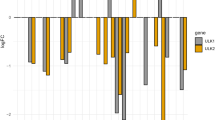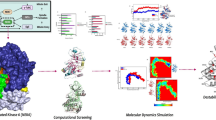Abstract
Ataxia telangiectasia-mutated (ATM) protein kinase, a key player in cellular integrity regulation, is known for its role in DNA damage response. This study investigates the broader impact of ATM on cellular processes and potential clinical manifestations arising from mutations, aiming to expand our understanding of ATM’s diverse functions beyond conventional roles. The research employs a comprehensive set of computational techniques for a thorough analysis of ATM mutations. The mutation data are curated from dbSNP and HuVarBase databases. A meticulous assessment is conducted, considering factors such as deleterious effects, protein stability, oncogenic potential, and biophysical characteristics of the identified mutations. Conservation analysis, utilizing diverse computational tools, provides insights into the evolutionary significance of these mutations. Molecular docking and dynamic simulation analyses are carried out for selected mutations, investigating their interactions with Y2080D, AZD0156, and quercetin inhibitors to gauge potential therapeutic implications. Among the 419 mutations scrutinized, five (V1913C, Y2080D, L2656P, C2770G, and C2930G) are identified as both disease causing and protein destabilizing. The study reveals the oncogenic potential of these mutations, supported by findings from the COSMIC database. Notably, Y2080D is associated with haematopoietic and lymphoid cancers, while C2770G shows a correlation with squamous cell carcinomas. Molecular docking and dynamic simulation analyses highlight strong binding affinities of quercetin for Y2080D and AZD0156 for C2770G, suggesting potential therapeutic options. In summary, this computational analysis provides a comprehensive understanding of ATM mutations, revealing their potential implications in cellular integrity and cancer development. The study underscores the significance of Y2080D and C2770G mutations, offering valuable insights for future precision medicine targeting-specific ATM. Despite informative computational analyses, a significant research gap exists, necessitating essential in vitro and in vivo studies to validate the predicted effects of ATM mutations on protein structure and function.
Graphical Abstract















Similar content being viewed by others
Data Availability
The datasets used and/or analyzed during the current study are available from the corresponding author on reasonable request.
Abbreviations
- ATR:
-
ATM- and Rad3-related
- ATM:
-
Ataxia telangiectasia mutated
- BRCA1:
-
Breast cancer type 1 susceptibility protein
- c-Abl:
-
Abelson tyrosine-protein kinase 1
- Chk1:
-
Checkpoint kinase 1
- Chk2:
-
Checkpoint kinase 2
- ConSurf:
-
Conservation of amino acid residues in proteins
- DNA:
-
Deoxyribonucleic acid
- DNA-PKc:
-
DNA-dependent protein kinase catalytic subunit
- DSB:
-
Double-stranded break
- FANCD2:
-
Fanconi anemia group D2 protein
- FATHMM-cancer:
-
Functional analysis through hidden Markov models
- IR:
-
Ionizing radiation
- MetaSNP:
-
Metastability-based SNP predictor
- Mdm2:
-
Murine double minute 2
- MDS:
-
Molecular dynamics simulation
- NbsS1:
-
Nijmegen breakage syndrome 1
- p53:
-
Tumour protein 53
- PIKK:
-
Phosphatidylinositol 3-kinase-related kinase
- Provean:
-
Protein variation effect analyzer
- Pmut:
-
Pathogenicity prediction software for missense variants
- Rad51:
-
DNA repair protein RAD51 homolog 1
- SDM2:
-
Site-directed mutator 2
- SNPs:
-
Single-nucleotide polymorphisms
- mCSM:
-
Mutations of computational saturation mutagenesis
- PyMOL:
-
Python molecular graphics system
References
Jackson, S. P., & Bartek, J. (2009). The DNA-damage response in human biology and disease. Nature, 461(7267), 1071–1078. https://doi.org/10.1038/nature08467
Roos, W. P., Thomas, A. D., & Kaina, B. (2016). DNA damage and the balance between survival and death in cancer biology. Nature Reviews Cancer, 16(1), 20–33. https://doi.org/10.1038/nrc.2015.2
O’Connor, M. J. (2015). Targeting the DNA damage response in cancer. Molecular Cell, 60(4), 547–560. https://doi.org/10.1016/j.molcel.2015.10.040
Savitsky, K., Sfez, S., Tagle, D. A., Ziv, Y., Sartiel, A., Collins, F. S., Shiloh, Y., & Rotman, G. (1995). The complete sequence of the coding region of the ATM gene reveals similarity to cell cycle regulators in different species. Human Molecular Genetics, 4(11), 2025–2032. https://doi.org/10.1093/hmg/4.11.2025
Bakkenist, C. J., & Kastan, M. B. (2003). DNA damage activates ATM through intermolecular autophosphorylation and dimer dissociation. Nature, 421(6922), 499–506. https://doi.org/10.1038/nature01368
Mochan, T. A., Venere, M., DiTullio, R. A., & Halazonetis, T. D. (2003). 53BP1 and NFBD1/MDC1-Nbs1 function in parallel interacting pathways activating ataxia-telangiectasia mutated (ATM) in response to DNA damage. Cancer Research, 63(24), 8586 LP–8591.
Wang, X., Chu, H., Lv, M., Zhang, Z., Qiu, S., Liu, H., Shen, X., Wang, W., & Cai, G. (2016). Structure of the intact ATM/Tel1 kinase. Nature Communications. https://doi.org/10.1038/ncomms11655
Baretić, D., Pollard, H. K., Fisher, D. I., Johnson, C. M., Santhanam, B., Truman, C. M., Kouba, T., Fersht, A. R., Phillips, C., & Williams, R. L. (2017). Structures of closed and open conformations of dimeric human ATM. Science Advances, 3(5), e1700933. https://doi.org/10.1126/sciadv.1700933
Yang, H., Jiang, X., Li, B., Yang, H. J., Miller, M., Yang, A., Dhar, A., & Pavletich, N. P. (2017). Mechanisms of mTORC1 activation by RHEB and inhibition by PRAS40. Nature, 552(7685), 368–373. https://doi.org/10.1038/nature25023
Yang, H., Rudge, D. G., Koos, J. D., Vaidialingam, B., Yang, H. J., & Pavletich, N. P. (2013). MTOR kinase structure, mechanism and regulation. Nature, 497(7448), 217–223. https://doi.org/10.1038/nature12122
Putti, S., Giovinazzo, A., Merolle, M., Falchetti, M. L., & Pellegrini, M. (2021, November 1). ATM kinase dead: From ataxia telangiectasia syndrome to cancer. Cancers. https://doi.org/10.3390/cancers13215498
Smith, J., Tho, L. M., Xu, N., & Gillespie, D. A. (2010). The ATM-Chk2 and ATR-Chk1 pathways in DNA damage signaling and cancer. Advances in Cancer Research, 108, 73–112. https://doi.org/10.1016/B978-0-12-380888-2.00003-0
Menolfi, D., & Zha, S. (2020). ATM, ATR and DNA-PKcs kinases—The lessons from the mouse models: Inhibition ≠ deletion. Cell & Bioscience, 10(1), 8. https://doi.org/10.1186/s13578-020-0376-x
Dash, R., & Munni, Y. A. (2020). Computational SNP analysis and molecular simulation revealed the most computational SNP analysis and molecular simulation revealed the most deleterious missense variants in the NBD1 domain of human ABCA1 transporter. International Journal of Molecular Sciences. https://doi.org/10.3390/ijms21207606
Panchal, N. K., Bhale, A., Verma, V. K., & Beevi, S. S. (2020). Computational and molecular dynamics simulation approach to analyze the impact of XPD gene mutation on protein stability and function. Molecular Simulation, 46(15), 1200–1219. https://doi.org/10.1080/08927022.2020.1810852
Panchal, N. K., Mohanty, S., & Prince, S. E. (2023). Computational insights into NIMA-related kinase 6: Unraveling mutational effects on structure and function. Molecular and Cellular Biochemistry. https://doi.org/10.1007/s11010-023-04910-0
Kumar, A., Rajendran, V., Sethumadhavan, R., & Purohit, R. (2012). In silico prediction of a disease-associated STIL mutant and its affect on the recruitment of centromere protein J (CENPJ). FEBS Open Bio, 2, 285–293. https://doi.org/10.1016/j.fob.2012.09.003
Capriotti, E., Altman, R. B., & Bromberg, Y. (2013). Collective judgment predicts disease-associated single nucleotide variants. BMC Genomics, 14(Suppl 3), S2. https://doi.org/10.1186/1471-2164-14-s3-s2
Choi, Y., & Chan, A. P. (2015). PROVEAN web server: A tool to predict the functional effect of amino acid substitutions and indels. Bioinformatics, 31(16), 2745–2747. https://doi.org/10.1093/bioinformatics/btv195
López-Ferrando, V., Gazzo, A., De La Cruz, X., Orozco, M., & Gelpí, J. L. (2017). PMut: A web-based tool for the annotation of pathological variants on proteins, 2017 update. Nucleic Acids Research, 45(W1), W222–W228. https://doi.org/10.1093/nar/gkx313
Pires, D. E. V., Ascher, D. B., & Blundell, T. L. (2014). MCSM: Predicting the effects of mutations in proteins using graph-based signatures. Bioinformatics, 30(3), 335–342. https://doi.org/10.1093/bioinformatics/btt691
Worth, C. L., Preissner, R., & Blundell, T. L. (2011). SDM—A server for predicting effects of mutations on protein stability and malfunction. Nucleic Acids Research, 39(SUPPL. 2), 215–222. https://doi.org/10.1093/nar/gkr363
Chen, C. W., Lin, M. H., Liao, C. C., Chang, H. P., & Chu, Y. W. (2020). iStable 2.0: Predicting protein thermal stability changes by integrating various characteristic modules. Computational and Structural Biotechnology Journal, 18, 622–630. https://doi.org/10.1016/j.csbj.2020.02.021
Parthiban, V., Gromiha, M. M., & Schomburg, D. (2006). CUPSAT: Prediction of protein stability upon point mutations. Nucleic Acids Research, 34(WEB. SERV. ISS.), 239–242. https://doi.org/10.1093/nar/gkl190
Capriotti, E., Fariselli, P., & Casadio, R. (2005). I-Mutant2.0: Predicting stability changes upon mutation from the protein sequence or structure. Nucleic Acids Research, 33(SUPPL. 2), 306–310. https://doi.org/10.1093/nar/gki375
Cheng, J., Randall, A., & Baldi, P. (2006). Prediction of protein stability changes for single-site mutations using support vector machines. Proteins, 62(4), 1125–1132. https://doi.org/10.1002/prot.20810
Rogers, M. F., Shihab, H. A., Mort, M., Cooper, D. N., Gaunt, T. R., & Campbell, C. (2018). FATHMM-XF: Accurate prediction of pathogenic point mutations via extended features. Bioinformatics, 34(3), 511–513. https://doi.org/10.1093/bioinformatics/btx536
Ashkenazy, H., Abadi, S., Martz, E., Chay, O., Mayrose, I., Pupko, T., & Ben-Tal, N. (2016). ConSurf 2016: An improved methodology to estimate and visualize evolutionary conservation in macromolecules. Nucleic Acids Research, 44(W1), W344–W350. https://doi.org/10.1093/nar/gkw408
Celniker, G., Nimrod, G., Ashkenazy, H., Glaser, F., Martz, E., Mayrose, I., Pupko, T., & Ben-Tal, N. (2013). ConSurf: Using evolutionary data to raise testable hypotheses about protein function. Israel Journal of Chemistry, 53(3–4), 199–206. https://doi.org/10.1002/ijch.201200096
Hemalatha, K., & Girija, K. (2016). Evaluation of drug candidature of some benzimidazole derivatives as biotin carboxylase inhibitors: Molecular docking and insilico studies. Asian Journal of Research in Pharmaceutical Science, 6(1), 15–20. https://doi.org/10.5958/2231-5659.2016.00002.3
Seeliger, D., & De Groot, B. L. (2010). Ligand docking and binding site analysis with PyMOL and Autodock/Vina. Journal of Computer-Aided Molecular Design, 24(5), 417–422. https://doi.org/10.1007/s10822-010-9352-6
Shiloh, Y., & Ziv, Y. (2013). The ATM protein kinase: Regulating the cellular response to genotoxic stress, and more. Nature Reviews Molecular Cell Biology, 14(4), 197–210. https://doi.org/10.1038/nrm3546
Lee, J.-H., & Paull, T. T. (2007). Activation and regulation of ATM kinase activity in response to DNA double-strand breaks. Oncogene, 26(56), 7741–7748. https://doi.org/10.1038/sj.onc.1210872
Maréchal, A., & Zou, L. (2013). DNA damage sensing by the ATM and ATR kinases. Cold Spring Harbor Perspectives in Biology, 5(9), a012716. https://doi.org/10.1101/cshperspect.a012716
Solayman, M., Saleh, M. A., Paul, S., Khalil, M. I., & Gan, S. H. (2017). In silico analysis of nonsynonymous single nucleotide polymorphisms of the human adiponectin receptor 2 (ADIPOR2) gene. Computational Biology and Chemistry, 68, 175–185. https://doi.org/10.1016/j.compbiolchem.2017.03.005
Jia, P., & Zhao, Z. (2017). Impacts of somatic mutations on gene expression: An association perspective. Briefings in Bioinformatics, 18(3), 413–425. https://doi.org/10.1093/bib/bbw037
Acknowledgements
The authors are thankful to the Vellore Institute of Technology, Vellore, India for providing the necessary facilities to carry out this work.
Funding
No funding was received for this work.
Author information
Authors and Affiliations
Contributions
Nagesh Kishan Panchal: idea for the article, literature survey, formal analysis, investigation, manuscript writing. Poorva Samdani: formal analysis, manuscript writing. Tiasa Sengupta: formal analysis, manuscript writing. Sabina Evan Prince: project administration, idea for the article, formal analysis, investigation, manuscript writing.
Corresponding author
Ethics declarations
Conflict of interest
All the authors declare no conflict of interest for this work.
Ethical Approval
Not applicable.
Consent to Participate
Not applicable: no human/animal subjects were involved in study.
Consent to Publish
Not applicable: no human/animal subjects were involved in study.
Additional information
Publisher's Note
Springer Nature remains neutral with regard to jurisdictional claims in published maps and institutional affiliations.
Supplementary Information
Below is the link to the electronic supplementary material.
Rights and permissions
Springer Nature or its licensor (e.g. a society or other partner) holds exclusive rights to this article under a publishing agreement with the author(s) or other rightsholder(s); author self-archiving of the accepted manuscript version of this article is solely governed by the terms of such publishing agreement and applicable law.
About this article
Cite this article
Panchal, N.K., Samdani, P., Sengupta, T. et al. Computational Analysis of Non-synonymous SNPs in ATM Kinase: Structural Insights, Functional Implications, and Inhibitor Discovery. Mol Biotechnol (2024). https://doi.org/10.1007/s12033-024-01120-x
Received:
Accepted:
Published:
DOI: https://doi.org/10.1007/s12033-024-01120-x




